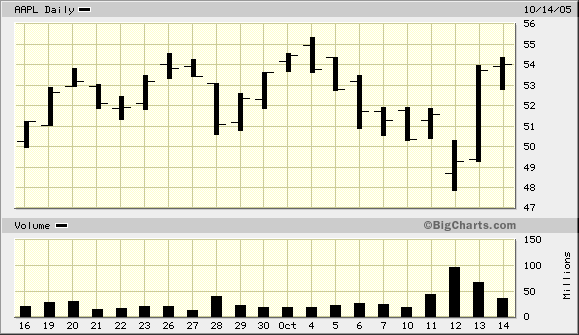Options traders can be wrong and still profit, here’s how
One of the myths that abound in options trading is that most options expire worthless. Well, maybe it’s not a myth, as somewhere between 75% and 99.9% of options do in fact expire worthless, depending on whom you ask. But does that mean you lose money over 3/4 of the time? I would argue that not only is the answer no, but depending on the management of a trade, both the buyer and seller of an option can profit within the same time frame.
Here’s a stock chart of Apple, courtesy of BigCharts.com, from September expiration through Friday’s close.

Let’s say at the close on September expiration Friday, Trader A bought 10 October 50-55 strangles from Trader B, and paid $3.40, for a total outlay of $3400.
Trader A is now long gamma, meaning his share equivalent position gets longer as Apple rallies, and shorter as it declines. If Trader A bought the straddle, he’s likely “betting” on volatility, and not direction (at least he should be,), so thus as AAPL approaches and hits 55, he becomes moderately long. He will sell some stock, so for argument’s sake I’m going to say he shorts 300 shares at an average price of 54 in late September, buys it back at 52 a couple days later, and then repeats the trade in early October. He’s now flipped Apple for $1200, effectively reducing the cost of his straddle to $2200.
Now earnings come out, and Apple dips down to $46 after hours, making Trader A very short. But let’s say Trader A misses that, but buys 500 shares the next morning at $49. Great move anyway, he can probably flip it for a $4 profit. Take that off his $2200 tab from above, and Trader A has now effectively paid $200 for the straddle, with a week to go still. And with Apple close to $54, he’s primed to short again into Apple strength, and maybe turn a profit. Or maybe not, but at worst his loss is negligible despite purchasing a straddle for $3400 that expires worthless.
How about Trader B. Well, if he did nothing, he’s up maybe $2700 (the $3400 he collected, less the current value of the strangle. But given Apple’s stock action, he may have gotten shaken into buying into strength and/or selling into weakness somewhere along the way. So let’s say he frittered away 2/3 of the value of the straddle in poor stock flipping. He’s still up $500 or so, with the potential to make another $800 if the stock closes between $50 and $55 on Friday.
Now of course I manipulated the actions of the two traders in this example, but I’m trying to demonstrate a point. Namely its possible for an option purchase to go bad, yet still produce a profit for the buyer. Additionally, its possible for both sides of the trade to come out ahead, depending on the behavior of the underlying stock.
My assumptions as to the actions of Trader A and Trader B were not unrealistic, if I assume each chooses his side of the trade based on his comfort level in managing his position after the transaction. Trader A is presumably proactive if he’s apt to buy strangles, because if he’s not, most of his trades will in fact become losers. Trader B is presumably able to mentally and financially handle the implications of selling a strangle, and able to both maintain the discipline needed to avoid big hits, while at the same time not “caving” at every tweak.
Adam Warner
Adam Warner is a proprietary trader for Addormar Co., Inc., specializing in option and derivative strategies. Prior to Addormar, he was an Equity Options Market Maker on the floor of the American Stock Exchange from 1988-2001.
